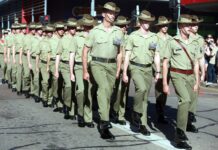

The following is an extended quote from the Australian War Memorial, recounting the heroic efforts of the Australian 4th Light Horse Brigade at Beersheba on 31 October 1917, which yesterday was 100 years to the day. The full article is well worthh the read. I am very proud of my forebears’ role in the defeat of the last of the Caliphates, which brought an end to a 1300 year old existential threat to Christendom:
“At 3:30 pm there was only a few hours of day light remaining and orders were issued for the final phase of the struggle, the occupation of Beersheba. Chauvel decided to put Grant’s 4th Light Horse Brigade straight at the remaining trenches, from the south-east. Chauvel knew that he must take the town before dark in order to secure the wells for Allenby’s large force. Private Keddie recorded: “We began to talk among ourselves saying Beersheba will be taken and us not doing anything when about 5 o’clock our major came and said that Beersheba had not been captured but we were going in.” Chauvel: “owing to the constant attacks from aeroplanes, which had devoted a good deal of attention to my own headquarters, it took some time to assemble them and push them off”. General Grant gave the order personally to the 12th Light Horse Regiment: “men you’re fighting for water. There’s no water between this side of Beersheba and Esani. Use your bayonets as swords. I wish you the best of luck”. The Light Horse were equipped with rifles and held their bayonets as swords, which would have been more suited to a cavalry style charge. Fortuitously their bayonet tips had been sharpened on the orders of Major General Hodgson, on 26 October.
“Grant made the decision to order his light horsemen to charge cavalry-style, when they would normally have ridden close to an objective then dismounted to fight. Trooper Edward Dengate: “we got mounted, cantered about a quarter of a mile up a bit of a rise lined up along the brow of a hill paused a moment, and then went atem, the ground was none too smooth, which caused our line to get twisted a bit . . . Captain Davies let out a yell at the top of his voice . . . that started them all we spurred our horses . . . the bullets got thicker…three or four horses came down, others with no riders on kept going, the saddles splashed with blood, here and there a man running toward a dead horse for cover, the Turk’s trenches were about fifty yards on my right, I could see the Turk’s heads over the edge of the trenches squinting along their rifles, a lot of the fellows dismounted at that point thinking we were to take the trenches, but most of us kept straight on, where I was there was a clear track with trenches on the right and a redoubt on the left, some of the chaps jumped clear over the trenches in places, some fell into them, although about 150 men got through and raced for the town, they went up the street yelling like madmen.” Captain Robey was at their head.
“Captain Jack Davies followed Robey’s men towards the town and shouted when three miles away: “Come on boys Beersheba first stop”. Major Fetherstonhaugh’s horse fell shot and was himself shot through the leg. The major put his horse out of its misery then got down behind his dead horse and fired his revolver until he ran out of ammunition. Fetherstonhaugh wrote to Davies congratulating him. In the letter he also mentioned his own injury: “I got a bullet through both thighs, it made a clean hole through the left but opened out a bit and made a large gash through the back of the right which will take a little while to fix up”.
“While the 4th Light Horse Regiment dismounted at the trenches and tackled their objective on foot many in the 12th Light Horse Regiment were able to get straight through and take the town, Keddie: “we were all at the gallop yelling like mad some had bayonets in their hand others their rifle then it was a full stretch gallop at the trenches . . . the last 200 yards or so was good going and those horses put on pace and next were jumping the trenches with the Turks underneath . . . when over the trenches we went straight for the town.”
“Sergeant Charles Doherty wrote that the horsemen who cleared all the trenches came up to an open plane which “was succeeded by small wadies and perpendicular gullies, surrounding which scores of sniper’s nests or dugouts each were holding seven or eight men. After progressing another quarter of a mile, we turned to the right at an angle of 45 degrees to converge on Beersheba. The enemy’s fire now came from the direction of the town and a large railway viaduct to the north. The limited number of entrances to the city temporarily checked us but those in front went straight up and through the narrow streets. Falling beams from fired buildings, exploding magazines and arsenals and various hidden snipers were unable to check our race through the two available streets that were wide enough for 2 to ride abreast.” Private Keddie had a near miss: “I felt a bullet go past my ear and thought if that bullet had been a few more inches to one side” as did Trooper Dengate: “I suppose you heard about the capture of Beersheba by the 4th Brigade, well I was right in it, and came through safe, and with my skin intact, I got a bullet through the leg of my breeches, just above the knee, grazed my leg but didn’t make it bleed.”
Lest We Forget.









